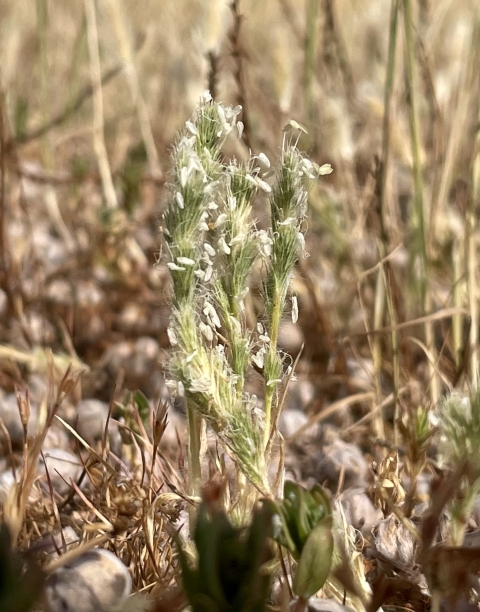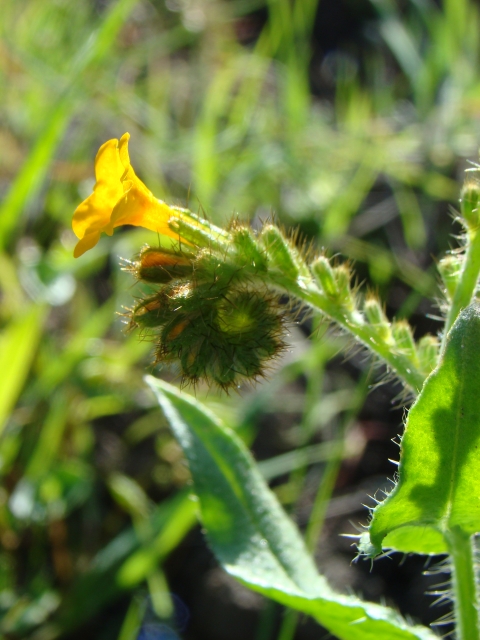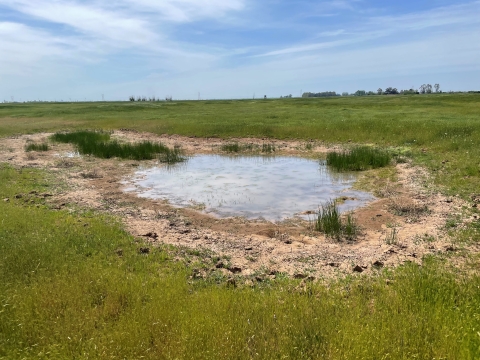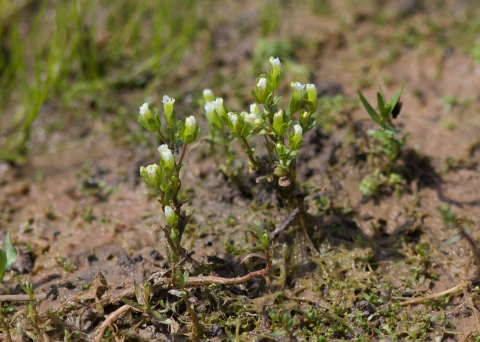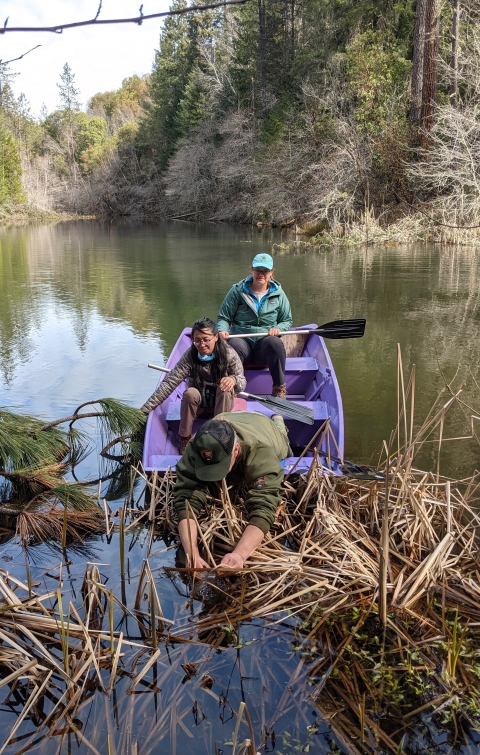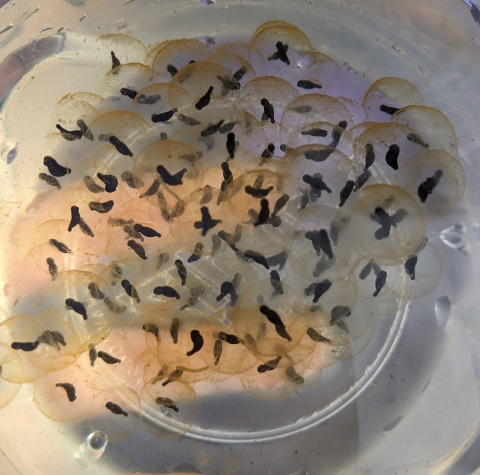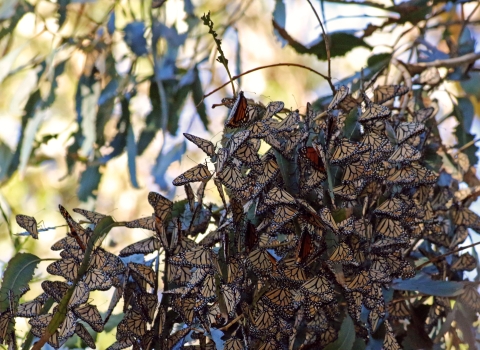Biologists from the Sacramento Fish and Wildlife Office work with a number of partners to collect data and evaluate habitat for listed and at-risk species. This hands-on work provides valuable insight into how species are doing and challenges they may face in the future. We’re capturing their initial observations here in “Conservation Corner.”
Endangered Frog Eggs Rescued from Stream Impacted by California’s Drought
July 13, 2022
In late May, U.S. Forest Service biologists on the Eldorado National Forest observed egg masses laid by Sierra Nevada yellow-legged frogs in a stream that was starting to run dry. The endangered frogs live in the high Sierra Nevada, and snowpack that feeds mountain streams was below normal in 2022.
“Unfortunately, as climate change climate change
Climate change includes both global warming driven by human-induced emissions of greenhouse gases and the resulting large-scale shifts in weather patterns. Though there have been previous periods of climatic change, since the mid-20th century humans have had an unprecedented impact on Earth's climate system and caused change on a global scale.
Learn more about climate change continues to impact snowpack and subsequent spring waterflows in the Sierra Nevada, stranded egg masses are becoming more common,” said Ian Vogel, senior biologist in the Sacramento Fish and Wildlife Office’s Sierra Cascades Division.
Biologists from the Sacramento FWO were notified of the situation, and they went out to the forest to support an egg relocation effort. Together with the USFS and biologists with the California Department of Fish and Wildlife, the egg masses were carefully moved from the drying inlet stream into an adjacent pond.
Recent status reports on the relocated egg masses are positive.
“In this instance, we were lucky that the Forest Service found these eggs before the stream dried up. Because of their quick actions, we were able to rescue and relocate the eggs into the adjacent pond where they will be given a much better chance to successfully hatch into tadpoles. These efforts help with the recovery of the species,” said Vogel.
Endangered Grass Making a Comeback
June 17, 2022
In May, biologists from the Sacramento Fish and Wildlife Office visited the Sylvan Preserve in Sacramento to survey for Sacramento Orcutt grass that had been introduced to some vernal pools on the property. As California enters its third straight year of drought, many vernal pools have been drying across the state impacting populations of species that consider these seasonal freshwater pools home.
“The Sylvan Preserve was identified as a great location to expand the existing population of this endangered plant due to health of the vernal pool system on the property,” said Nora Papian, senior biologist in the Sacramento Fish and Wildlife Office’s Conservation Planning Division.
The U.S. Fish and Wildlife Service provided a grant to support the seeding effort on the preserve in 2017. Carol Witham, a local biologist and Central Valley vernal pool expert, closely monitored the seeding effort and reported back to the Sacramento FWO on the progress. While early results of the effort were positive, California plunged into two years of severe drought with late-season rains. During 2020 and 2021, few to no Orcutt grass were detected during surveys of pools where the grass was introduced or occurred naturally. However, even though California is still in a drought, the 2022 survey discovered 1,132 plants in seven vernal pools.
“We are very happy to see these results. The Sacramento Orcutt grass continues to defy the odds and persist despite challenging environmental conditions. We’re grateful for partners like Carol who are champions for California’s vernal pools,” said Papian.
The Sacramento FWO is in the process of developing the 5-year review for the species and expects to publish it in the next year.
New Population of Endangered Large-Flowered Fiddleneck Found
May 18, 2022
News of a yellow flower has Sacramento Fish and Wildlife Office biologists excited! Previously known to exist at only 11 sites, a new population of endangered large-flowered fiddleneck was recently discovered in East Bay Regional Park District’s Black Diamond Mines Regional Preserve in Contra Costa County. The Service was made aware of the discovery after rangeland managers at the preserve confirmed the find with partners in environmental consulting.
“Finding a new population of a listed species is always exciting, but it makes it even more exciting knowing that the species faced extinction not too long ago,” said Sam Sosa, senior biologist in the SFWO’s Sierra Cascades division. “The fiddleneck rebounded from a population size of 26 plants in 2009 to over 55,000 plants last year due to the immense work of our partners.”
In recent years, large-flowered fiddleneck has been the focus of extensive restoration efforts that include closely managing populations that have been reintroduced to areas in its native range. Before this new population was found, there was only one natural population surviving without intense management.
“This newly discovered natural population, now one of only two that we know are still around, creates a foothold in a part of its range that needs help,” added Sosa. “To me, this discovery is the fiddleneck’s way of saying that it wants to survive. The fiddleneck is telling us where it wants to grow. This discovery gives us hope that the fiddleneck will be found in every place where it used to live and that it will be around for future generations.”
Restoration and Seeding Supports Vernal Pool Species Recovery
April 26, 2022
In early April, Sacramento Fish and Wildlife Office senior biologists, Nora Papian and Stephanie Jentsch, visited the Markham Ravine restoration project in Placer County, California to view recently restored vernal pools. Over the past four years, Westervelt Ecological Services, in partnership with the Placer County Conservation Program, has been restoring the property from irrigated pastureland to native vernal pool grasslands and riparian riparian
Definition of riparian habitat or riparian areas.
Learn more about riparian wetlands.
Vernal pools, and the species that call them home, have disappeared from much of California due to intensive agricultural practices, land development and invasive species invasive species
An invasive species is any plant or animal that has spread or been introduced into a new area where they are, or could, cause harm to the environment, economy, or human, animal, or plant health. Their unwelcome presence can destroy ecosystems and cost millions of dollars.
Learn more about invasive species .
“Vernal pools are unique ecosystems that support a wide range of plant and animal species that are adapted to California’s wet and dry cycles. Efforts like this restoration project are helping to recover listed and at-risk species,” said Jentsch.
Part of the restoration effort included sowing vernal pools with soil that contained Boggs Lake Hedge-hyssop seeds and federally threatened vernal pool fairy shrimp cysts. While the plant is not federally protected, it is listed as endangered by the state of California.
"This area was identified as a good seeding location for the hedge-hyssop because it’s within the plant’s historic range and it has the right soil type and precipitation levels," said Papian.
During the visit, the biologists were pleased to see that the plant successfully grew from seed and flowered in several vernal pools despite low rainfall this winter. A population count has not yet been completed, but biologists are hopeful that the Boggs Lake hedge-hyssop can successfully establish at the reserve.
"From this effort, we learned that establishing new populations of hedge-hyssop from seed is possible,” said Papian. “This project also demonstrates that native plant seed collection and distribution in the proper locations can be an important part of recovering listed and at-risk plants.”
In addition to the success seen with the plant, surveys conducted over the winter found vernal pool fairy shrimp in several pools at the site. The presence of the tiny, freshwater crustacean in the restored pools suggests that the site can again provide habitat for fairy shrimp and other vernal pool plant and animal species.
The SFWO will continue to coordinate with Westervelt and the Placer County Conservation Program in the management of this and future sites that help offset development impacts on species and their habitat in Western Placer County.
"We are grateful for the partnership with the Placer County Conservation Program and Westervelt to restore this site to vernal pool grassland and recover species that depend on this habitat,” said Jentsch. “This is a great achievement, and we're looking forward to seeing even more success with these partners in the coming years."
Searching for Salamanders
April 18, 2022
In mid-March, Service biologists from the Sacramento Fish and Wildlife Office (SFWO) headed out to the Santa Rosa Plain with Dave Cook of the Sonoma County Water Agency to survey vernal pools for larvae of the endangered California tiger salamander (Sonoma distinct population segment). They used dip-nets to find the salamander larvae in the pools, but unfortunately, their findings were slim. Larvae were found in just one small pool.
“The survey’s results were sobering and in-line with the mega drought's unrelenting influence on vernal pool systems,” said John Cleckler, biologist in the SFWO’s Coast-Bay Division.
Vernal pools, which are seasonal wetlands that occur with winter rains, are critical breeding areas for tiger salamanders. The salamanders lay their eggs in shallow bodies of water like other amphibians. Loss of vernal pool habitat has contributed to the salamander’s decline.
“The pools will most likely dry before the larvae can transform into air breathing, terrestrial salamanders,” said Cleckler.
Cook has been monitoring salamander populations on the Santa Rosa Plain for close to 20 years. In addition to the Service, graduate students and volunteers from local environmental consulting agencies joined this year’s effort to understand the impact of California’s multi-year drought on salamander populations.
“This was a real eye-opener of the overall lack of water this year,” added Toby McBride, senior biologist in SFWO’s Conservation Banking Division. “We need more rain to fill the ponds. Salamanders are more likely to have breeding success in deeper ponds.”
Conservation of vernal pool ecosystems has been a special focus of the Service, with 20 threatened and endangered species and 13 species of concern tied to vernal pools in California and southern Oregon. You can explore the Service’s recovery plan for these species here.
California red-legged frog eggs destined for a new home in Yosemite
April 11, 2022
In mid-March, biologists from the Sacramento Fish and Wildlife Office accompanied Rob Grasso, aquatic ecologist from Yosemite National Park, in collecting California red-legged frog eggs from a lake owned by a longtime conservation partner.
After carefully gathering a number of slippery egg masses and placing them in coolers, Service biologists took the masses to the San Francisco Zoo. There, the zoo raises the frogs to adulthood. Once fully grown, the frogs are released in ponds at Yosemite National Park where they are monitored by Park biologists.
In partnership with the San Francisco Zoo, Oakland Zoo and Yosemite National Park, this effort is helping recover populations of the California red--legged frog in the Sierra.
“This project highlights the importance of partnerships. We are fortunate to work alongside biologists from the National Park Service, staff at the San Francisco Zoo, and a private landowner, all of whom are dedicated, passionate conservationists. It really does take a team to enact successful conservation,” said Service senior biologist Ian Vogel, who was among the group in the field.
The California red-legged frog (Rana draytonii) is a threatened species that lives in wetlands along the California coast and Sierra foothills. One threat to the frog is the introduction of non-native aquatic predators, including bullfrogs, which prey upon a wide range of species and represent a serious threat to wetland ecosystems. Bullfrog removal has been a focus for managers at Yosemite National Park since 2005, so when the adult red-legged frogs are released into their new lake homes in the park, they will thrive in a restored ecosystem. Click here to learn more about how the Service is helping to recover this species.


